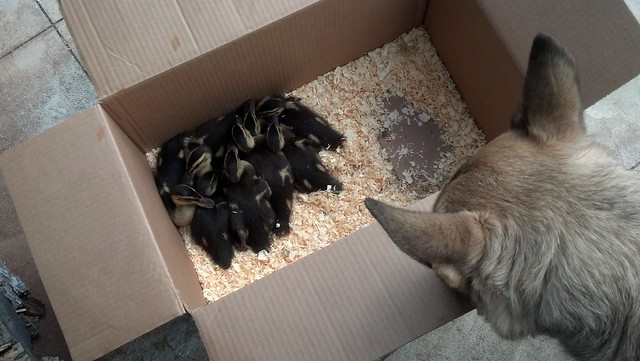there's something funny going on around the homestead
we got our mallards last year, three of them, by the end of the summer we had a dozen, they all flew off in the fall
we waited several weeks this spring, saw none return, so we picked up these 8 from the farm store a month ago

they have gotten big, fast!
we have had a few wild ones land in the pond, and the domestics chase them off after 10 minutes
today, I walked out and saw what I thought was a baby duckling laying in front of where the domestics were laying in the grass, as soon as I stepped out into the yard it bolted into the reeds, so we spent all afternoon looking for it, I finally got this video, you can see how big our 2 month old domestics are in the last few seconds of the video
Now, our domestics are way to juvenile to be breeding, wild ones have not been around enough to nest,here is their breeding cycle
Mallards usually form pairs (in October and November in the Northern hemisphere) only until the female lays eggs at the start of nesting season which is around the beginning of spring, at which time she is left by the male who joins up with other males to await the moulting period which begins in June (in the Northern hemisphere). During the brief time before this, however, the males are still sexually potent and some of them either remain on standby to sire replacement clutches (for female Mallards that have lost or abandoned their previous clutch) or forcibly mate with females that appear to be isolated or unattached regardless of their species and whether or not they have a brood of ducklings.
The nesting period can be very stressful for the female since she lays more than half her body weight in eggs. She requires a lot of rest and a feeding/loafing area that is safe from predators. When seeking out a suitable nesting site, the female's preferences are areas that are well concealed, inaccessible to ground predators, or have few predators nearby. This can include nesting sites in urban areas such as roof gardens, enclosed courtyards, and flower boxes on window ledges and balconies more than one story up, which the ducklings cannot leave safely without human intervention. The clutch is 8–13 eggs, which are incubated for 27–28 days to hatching with 50–60 days to fledgling. The ducklings are precocial and fully capable of swimming as soon as they hatch. However, filial imprinting compels them to instinctively stay near the mother not only for warmth and protection but also to learn about and remember their habitat as well as how and where to forage for food. When ducklings mature into flight-capable juveniles, they learn about and remember their traditional migratory routes (unless they are born and raised in captivity). After this, the juveniles and the mother may either part or remain together until the breeding season arrives
that thing didn't fly in on it's own,it is probably less than half the size of our domestics when we got them, where the heck did it come from?
Most Users Ever Online: 698
Currently Online:
33 Guest(s)
Currently Browsing this Page:
2 Guest(s)
Top Posters:
easytapper: 2149
DangerDuke: 2030
groinkick: 1667
PorkChopsMmm: 1515
Gravel Road: 1455
Newest Members:
Forum Stats:
Groups: 1
Forums: 12
Topics: 11482
Posts: 58640
Member Stats:
Guest Posters: 2
Members: 19842
Moderators: 0
Admins: 1
Administrators: K

 Log In
Log In Home
Home
 Offline
Offline







